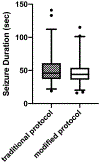Modified Anesthesia Protocol for Electroconvulsive Therapy Permits Reduction in Aerosol-Generating Bag-Mask Ventilation during the COVID-19 Pandemic
- PMID: 32554959
- PMCID: PMC7483857
- DOI: 10.1159/000509113
Modified Anesthesia Protocol for Electroconvulsive Therapy Permits Reduction in Aerosol-Generating Bag-Mask Ventilation during the COVID-19 Pandemic
Abstract
Introduction: Electroconvulsive therapy (ECT) is a critical procedure in psychiatric treatment, but as typically delivered involves the use of bag-mask ventilation (BMV), which during the COVID-19 pandemic exposes patients and treatment staff to potentially infectious aerosols.
Objective: To demonstrate the utility of a modified anesthesia protocol for ECT utilizing preoxygenation by facemask and withholding the use of BMV for only those patients who desaturate during the apneic period.
Methods: This chart review study analyzes patients who were treated with ECT using both the traditional and modified anesthesia protocols.
Results: A total of 106 patients were analyzed, of whom 51 (48.1%) required BMV using the new protocol. Of clinical factors, only patient BMI was significantly associated with the requirement for BMV. Mean seizure duration reduced from 52.0 ± 22.4 to 46.6 ± 17.1 s, but seizure duration was adequate in all cases. No acute physical, respiratory, or psychiatric complications occurred during treatment.
Conclusions: A modified anesthesia protocol reduces the use of BMV by more than 50%, while retaining adequate seizure duration.
Keywords: COVID-19; Cohort studies; Electroconvulsive therapy; General anesthesia; Mechanical ventilation.
© 2020 S. Karger AG, Basel.
Figures

Similar articles
-
Ventilation Adjustment in ECT During COVID-19: Voluntary Hyperventilation is an Effective Strategy.Neuropsychiatr Dis Treat. 2021 May 20;17:1563-1569. doi: 10.2147/NDT.S303877. eCollection 2021. Neuropsychiatr Dis Treat. 2021. PMID: 34045858 Free PMC article.
-
Electroconvulsive Therapy Practice Changes in Older Individuals Due to COVID-19: Expert Consensus Statement.Am J Geriatr Psychiatry. 2020 Nov;28(11):1133-1145. doi: 10.1016/j.jagp.2020.08.001. Epub 2020 Aug 7. Am J Geriatr Psychiatry. 2020. PMID: 32863137 Free PMC article.
-
ECT in the time of the COVID-19 pandemic.Australas Psychiatry. 2020 Oct;28(5):527-529. doi: 10.1177/1039856220953705. Epub 2020 Sep 13. Australas Psychiatry. 2020. PMID: 32924540
-
Electroconvulsive therapy, personal protective equipment and aerosol generating procedures: a review to guide practice during Coronavirus Disease 2019 (COVID-19) pandemic.Australas Psychiatry. 2020 Dec;28(6):632-635. doi: 10.1177/1039856220953699. Epub 2020 Sep 10. Australas Psychiatry. 2020. PMID: 32910692 Review.
-
Recommendation of a practical guideline for safe tracheostomy during the COVID-19 pandemic.Eur Arch Otorhinolaryngol. 2020 Aug;277(8):2173-2184. doi: 10.1007/s00405-020-05993-x. Epub 2020 Apr 21. Eur Arch Otorhinolaryngol. 2020. PMID: 32314050 Free PMC article. Review.
Cited by
-
An Online Survey About Electroconvulsive Therapy in Japan During the COVID-19 Pandemic: Comparison of Early and Recent Stages.Neuropsychiatr Dis Treat. 2022 Jun 28;18:1277-1285. doi: 10.2147/NDT.S365417. eCollection 2022. Neuropsychiatr Dis Treat. 2022. PMID: 35789588 Free PMC article.
-
Tolerability and Clinical Outcomes With Anesthesia Dose Reduction During Electroconvulsive Therapy.JAMA Netw Open. 2025 Feb 3;8(2):e2462054. doi: 10.1001/jamanetworkopen.2024.62054. JAMA Netw Open. 2025. PMID: 40014343 Free PMC article.
-
Ventilation Adjustment in ECT During COVID-19: Voluntary Hyperventilation is an Effective Strategy.Neuropsychiatr Dis Treat. 2021 May 20;17:1563-1569. doi: 10.2147/NDT.S303877. eCollection 2021. Neuropsychiatr Dis Treat. 2021. PMID: 34045858 Free PMC article.
-
Impact of COVID-19 on electroconvulsive therapy practice across Canadian provinces during the first wave of the pandemic.BMC Psychiatry. 2023 May 10;23(1):327. doi: 10.1186/s12888-023-04832-7. BMC Psychiatry. 2023. PMID: 37165333 Free PMC article.
-
Anesthetic care for electroconvulsive therapy.Anesth Pain Med (Seoul). 2022 Apr;17(2):145-156. doi: 10.17085/apm.22145. Epub 2022 Apr 15. Anesth Pain Med (Seoul). 2022. PMID: 35538655 Free PMC article. Review.
References
-
- Sackeim HA. Modern Electroconvulsive Therapy: Vastly Improved yet Greatly Underused. JAMA Psychiatry. 2017. August 1;74(8):779–80. - PubMed
-
- Munk-Olsen T, Laursen TM, Videbech P, Mortensen PB, Rosenberg R. All-cause mortality among recipients of electroconvulsive therapy: Register-based cohort study. Br J Psychiatry. 2007. May;190(5):435–9. - PubMed
-
- Mirzakhani H, Guchelaar H-J, Welch CA, Cusin C, Doran ME, MacDonald TO, et al. Minimum Effective Doses of Succinylcholine and Rocuronium During Electroconvulsive Therapy: A Prospective, Randomized, Crossover Trial. Anesth Analg. 2016;123(3):587–96. - PubMed
-
- Bryson EO, Aloysi AS, Farber KG, Kellner CH. Individualized Anesthetic Management for Patients Undergoing Electroconvulsive Therapy: A Review of Current Practice. Anesth Analg. 2017. June; 124(6): 1943–56. - PubMed
MeSH terms
Substances
Grants and funding
LinkOut - more resources
Full Text Sources
Medical

